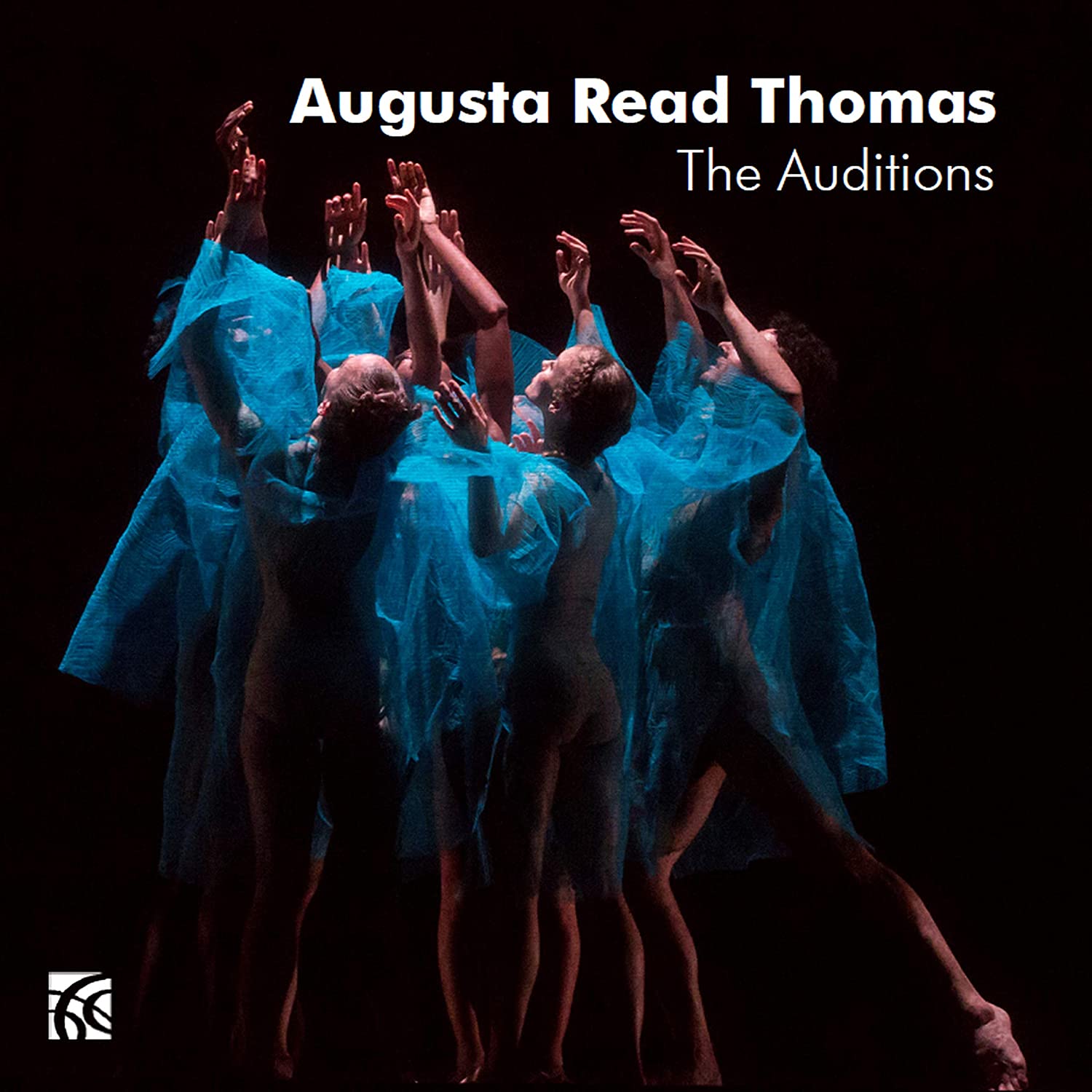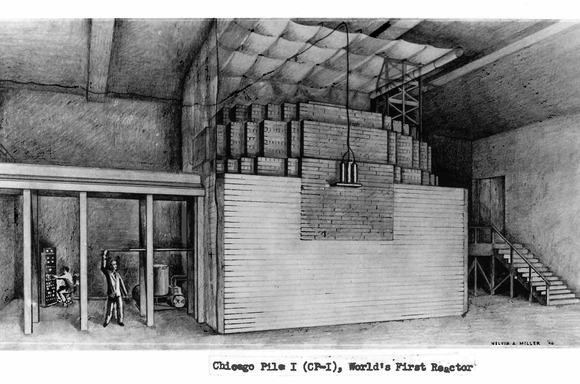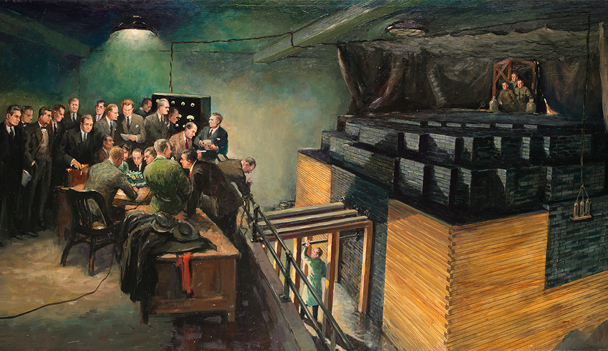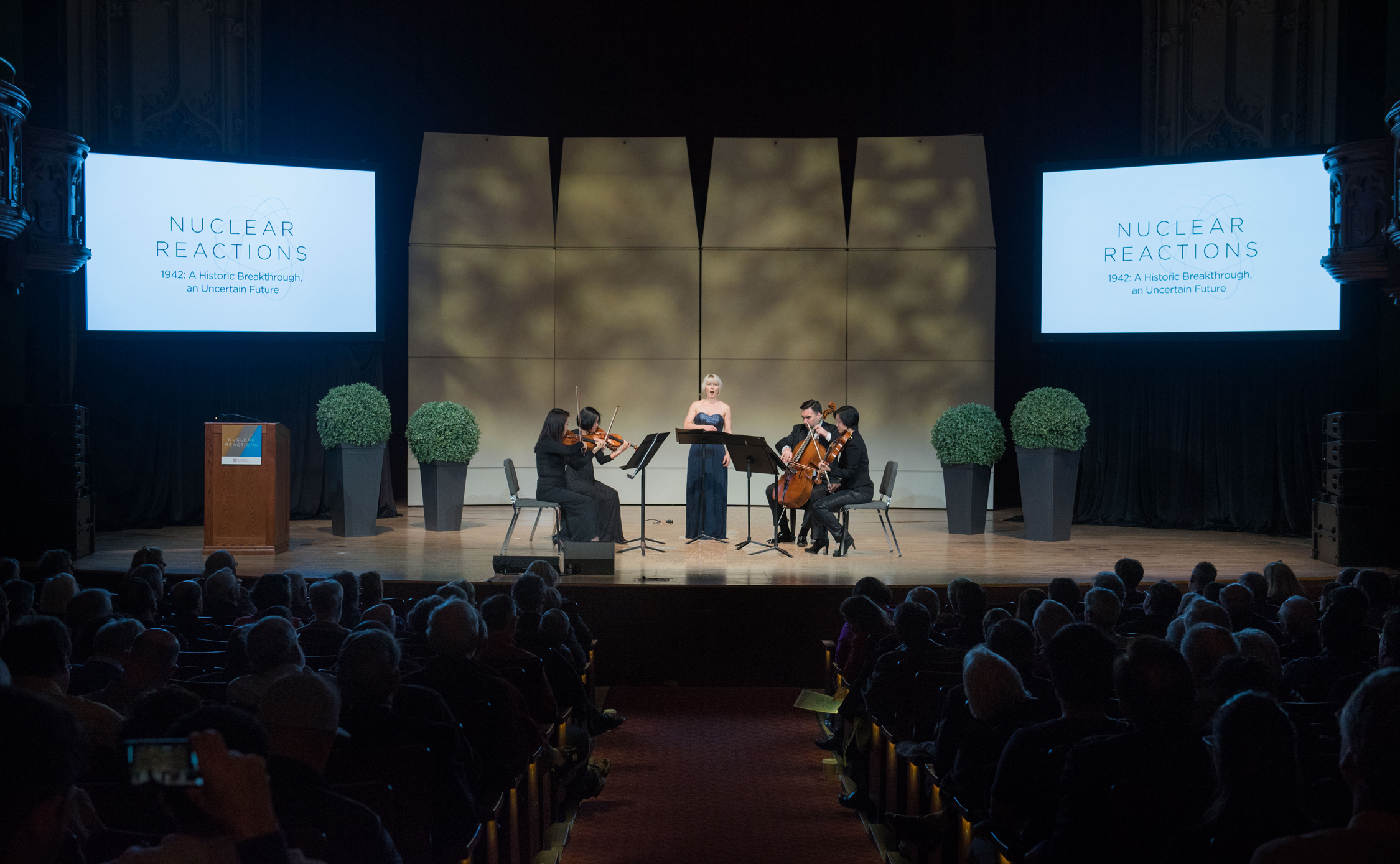The range of the soprano vocalise (and of all the instrumental options below) is the twelfth from D4 to A5.
Commissioned by The University of Chicago for the Commemoration of the 75th Anniversary of Chicago Pile-1
First performance by Jessica Aszodi, Soprano, and Chicago Symphony Orchestra Musicians: Yuan-Qing Yu and Ni Mei, Violins; WeiJing Wang, Viola; and Ken Olsen, Cello on 1 December 2017 in a private conference-style event in Mandel Hall.
The World Premiere of the chamber orchestra version of PLEA FOR PEACE for soprano and string orchestra, was given by International Sejong Soloists in Zankel Hall at Carnegie Hall on 9 November 2018.
The World Premiere of the chamber orchestra version of PLEA FOR PEACE for flute, oboe, trumpet and string orchestra, was given by Gerard Schwarz, conducting the Eastern Music Festival Orchestra in Greensboro, NC. on 30 June 2018.
The World Premiere of the vibraphone version of PLEA FOR PEACE for vibraphone (plus triangle and one crotale) was given by the Chen String Quartet – Robert Chen and Laura Park Chen, violins; Beatrice Chen, viola; Noah Chen, cello – and percussionist Joshua Graham, presented by Classical Music Chicago, in Chicago, IL on 29 July 2025.
Alternate versions:
1. The vocalise solo line can also be performed by Flute, Alto Flute, Oboe, Clarinet, Trumpet, Soprano Saxophone, Violin, Viola, Cello, or Countertenor in place of the Soprano.
2. May also be performed with string orchestra (no basses).
3. There is a version where the vocalize is shared between Flute, Oboe, Trumpet with string orchestra (no basses)
4. There is a version where the vocalize is played by vibraphone with one triangle and one crotale.
Duration: 6 minutes

This work is available on
Augusta Read Thomas: The Auditions
All-Star Orchestra Plea for Peace
Augusta Read Thomas on Plea for Peace
Curtis 2021 Ensemble - Augusta Read Thomas: Plea for Peace, Sophia Hunt, soprano; Claire Bourg, violin; Takumi Taguchi, violin; Grace Takeda, viola; John Lee, cello
Jennie Oh Brown, alto flute; Elizabeth Brausa Brathwaite, violin; Kate Carter, violin; Dominic Johnson, viola; Paula Kosower, cello
Plea for Peace, the Trumpet Version. Amanda Ross, trumpet; Emelyn Bashour & Megan Rohrer, violins; Courtney Bonifant, viola; Wesley Hornpetrie, cello
Assistant Professor of Music and the Humanities, University of Chicago
The history of music is, in many ways, an assemblage of occasional compositions. Since the rise of art pour l’art in the nineteenth century, classical music purports to be abstract, but in the longer arc, compositions connect to specific occasions: a coronation, a requiem mass, a religious feast, a dinner party, a regal celebration. Such occasions and commissions present challenges––not least for the composer charged with responding to the myriad consequences of the world’s first nuclear reaction. Does one focus on the (positive) reverberations in cancer treatment, power, and science? Does one focus on the (negative) reverberations in bombs, death, waste, and perpetual threats of war? In Plea for Peace, these consequences are inextricable. The clean perfect intervals that begin and end the work give rise to both expansionist leaps and cocooning retractions. The soloist’s elegant, wordless vocalise weaves in and out of the string quartet’s sustained harmonies in graceful counterpoint, drawing us closer to our common humanity. Simple harmonies slowly transform, becoming rich and complex at the insistent, dramatic climax: a wordless scream from the soul. As the music’s opening glow returns, the voice seamlessly dovetailing with the strings, we return to the sonic space of meditation, reflecting on an absolute plea for lasting peace.
Copyright © Jennifer Iverson
Scored for wordless soprano and string quartet, Plea for Peace acts as a single, seamless block beginning in near-immobility, with the voice animating the instruments as the music embarks on its slow, implacable progress. With the voice and instruments' lines constantly interweaving and building upon each other, the music imperceptibly grows in fervour without ever changing its spaciously inexorable pace. The work's ultimate peak is as vociferous as it is inevitable. But, as the ending winds back to the opening stillness, there's no sense of fulfilment or arrival. The listener, along with the music, is left awaiting an answer to this impassioned plea.
Copyright © Paul Pellay
Chicago Pile-1 (CP-1), when it achieved criticality, became the world's first artificial nuclear reactor. Its construction was part of the Manhattan Project, the Allied effort to create atomic bombs during World War II. It was built by the Manhattan Project's Metallurgical Laboratory at the University of Chicago, under the west viewing stands of the original Stagg Field. The first human-made self-sustaining nuclear chain reaction was initiated in CP-1 on 2 December 1942, under the supervision of Enrico Fermi, who described the apparatus as "a crude pile of black bricks and wooden timbers".
The reactor was assembled in November 1942, by a team that included Fermi, Leo Szilard (who formulated the idea of the chain reaction), Herbert L. Anderson, Walter Zinn, Martin D. Whitaker, and George Weil. It contained 45,000 graphite blocks weighing 400 short tons (360 t) used as neutron moderators, and was fueled by 6 short tons (5.4 t) of uranium metal and 50 short tons (45 t) of uranium oxide. In the pile, some of the free neutrons produced by the natural decay of uranium were absorbed by other uranium atoms, causing nuclear fission of those atoms, and the release of additional free neutrons. Unlike most subsequent nuclear reactors, it had no radiation shielding or cooling system as it only operated at very low power. The shape of the pile was intended to be roughly spherical, but as work proceeded, Fermi calculated that critical mass could be achieved without finishing the entire pile as planned.
In 1943, CP-1 was moved to Red Gate Woods, and reconfigured to become Chicago Pile-2 (CP-2). There, it was operated until 1954, when it was dismantled and buried. The stands at Stagg Field were demolished in August 1957, but the site is now a National Historic Landmark and a Chicago Landmark


When the Chicago Pile-1 went critical on December 2, 1942, a coded call from UChicago to Harvard merely said, “the Italian Navigator has just landed in the New World, [and] the earth was not as large as he had estimated….” Humanity had breached a monumental threshold underneath the deeply ordinary stands of the University of Chicago’s Stagg Field, passing into an age that would fundamentally alter the terms of our existence—and yet did so almost unexpectedly, before the pile’s stack of graphite blocks and uranium cylinders was even complete. As we approach the 75th anniversary of CP-1, we must recall the vast and enduring consequences that flowed from this somewhat crude and unstable material moment: although the first artificial, self-sustaining nuclear chain reaction produced only enough energy to light an incandescent bulb, the incommensurable scale of the research that followed from this experiment reshaped the world through innovations in agriculture, medicine, and nuclear power, while at the same time inaugurating the possibility of man-made extinction.
Copyright © Sean Keller

Louis Harris, Third Coast Review May 12, 2023 "The concert started great with Thomas’ meditation, Plea for Peace. Scored for wordless soprano and string quartet, Picosa substituted Brown’s flute for the soprano. It starts with a lush opening with long notes and a subtle buildup as melodies emerge. Brown’s flute sang over the string quartet, which seemed well coordinated. Their vibratos were perfect and the sound was lush."
The America Record Guide, February, 2020 "Augusta Read Thomas's Plea for Peace (transcribed for alto flute and strings) is soft and tender, and yet shows from the beginning an immense, tensile strength."
Jim Ruggirello, The Grunion, Long Beach, California, March 29, 2019 "Soprano Marlissa Hudson led off with Thomas's “Plea for Peace,” a haunting wordless vocalise over string quartet [which is] evocative and moving. Sometimes you don’t need words."
To obtain examination or performance material for this
Augusta Read Thomas work, please contact Nimbus Music Publishing.
